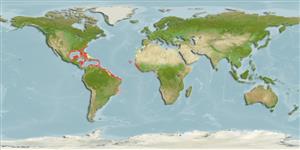Teleostei (teleosts) >
Holocentriformes (Squirrelfishes, soldierfishes) >
Holocentridae (Squirrelfishes, soldierfishes) > Myripristinae
Etymology: Myripristis: Greek, myros, -ou = male of morey eel + Greek, pristis = saw (Ref. 45335).
Eponymy: Jacobus is a latinization of James, and refers to the fish’s local name Frère-Jacques (Brother Jim) in Martinique, which is the type locality. (Ref. 128868), visit book page.
More on author: Cuvier.
Environment: milieu / climate zone / depth range / distribution range
Ecology
Marine; reef-associated; depth range 0 - 210 m (Ref. 115215), usually 2 - 35 m (Ref. 40849). Subtropical; 37°N - 23°S, 98°W - 9°E
Western Atlantic: North Carolina (USA), Bahamas and northern Gulf of Mexico to Brazil; throughout the West Indies and the Caribbean Sea (Ref. 3724). Eastern Atlantic: St. Paul's Rocks (Ref. 13121), Cape Verde, Principe, Ascension and St. Helena islands (Ref. 6537).
Size / Weight / Age
Maturity: Lm ? range ? - ? cm
Max length : 25.0 cm TL male/unsexed; (Ref. 5217); common length : 20.0 cm TL male/unsexed; (Ref. 5217)
Dorsal spines (total): 11; Dorsal soft rays (total): 14; Anal spines: 4; Anal soft rays: 13 - 14. Soft dorsal and anal fins covered with scales (Ref. 13608). Dark brown vertical bar runs along gill opening to pectoral fin (Ref. 26938). Body deep, compressed and robust (Ref. 37108). Body reddish above, paling to silvery below. Spinous dorsal fin with red and white markings. Edges of all fins are white. Preopercular spine not prominent. Lobes of caudal, soft dorsal and anal fins pointed (Ref. 7251).
Found from shallow coral reefs to offshore deeper waters (Ref. 3724). A nocturnal species aggregating around coral reefs and deeper rocky reefs (Ref. 3724). Feeds mainly on planktonic organisms (Ref. 3724). Occasionally found swimming upside down (Ref. 9710). Marketed fresh but not popular as a food fish (Ref. 5217).
Life cycle and mating behavior
Maturity | Reproduction | Spawning | Eggs | Fecundity | Larvae
Robins, C.R. and G.C. Ray, 1986. A field guide to Atlantic coast fishes of North America. Houghton Mifflin Company, Boston, U.S.A. 354 p. (Ref. 7251)
IUCN Red List Status (Ref. 130435: Version 2024-2)
Threat to humans
Harmless
Human uses
Fisheries: minor commercial; aquarium: commercial
Tools
Special reports
Download XML
Internet sources
Estimates based on models
Preferred temperature (Ref.
123201): 23.6 - 28, mean 26.6 °C (based on 652 cells).
Phylogenetic diversity index (Ref.
82804): PD
50 = 0.5000 [Uniqueness, from 0.5 = low to 2.0 = high].
Bayesian length-weight: a=0.01445 (0.00808 - 0.02587), b=3.01 (2.85 - 3.17), in cm total length, based on LWR estimates for this species & Genus-body shape (Ref.
93245).
Trophic level (Ref.
69278): 3.4 ±0.2 se; based on diet studies.
Resilience (Ref.
120179): High, minimum population doubling time less than 15 months (Preliminary K or Fecundity.).
Fishing Vulnerability (Ref.
59153): Low vulnerability (15 of 100).
Nutrients (Ref.
124155): Calcium = 39.6 [16.0, 105.5] mg/100g; Iron = 0.697 [0.277, 1.494] mg/100g; Protein = 19.2 [17.9, 20.3] %; Omega3 = 0.284 [0.111, 0.698] g/100g; Selenium = 21.1 [10.5, 42.4] μg/100g; VitaminA = 42.4 [14.1, 136.7] μg/100g; Zinc = 0.874 [0.531, 1.408] mg/100g (wet weight);
